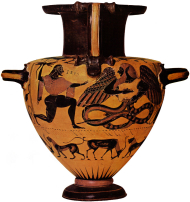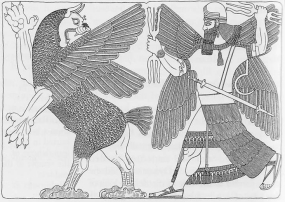Text
The Typhon episode in Hesiod’s Theogony (820-880) is as follows: a monstruous creature, previously unheard of, is born from Earth and Tartarus and grows great, threatening Zeus’ power. There is a battle between the two, and Zeus, using his storm weapons, which include the usual thunder and lightning and also tornadoes, overwhelms his opponent and destroys him. Typhon himself is some sort of stormdemon: although consigned to Tartarus, he is the source of wild, destructive winds. The Typhon episode does not fit very well into the structure of the Succession Myth and should be regarded as a separate, self-contained story drawn from the general area of tradition, and it may be compared with several oriental myths. The myth has many important Mesopotamian, Canaanite and Hurro-Hittite parallels.
Among them is the Sumerian poem Lugale which tells of Ninurta’s defeat of terrible Azag and his army of stones. The salient points of comparison are that Azag is born of Earth and Heaven (26); it grows mighty and aspires to Ninurta’s kingship. Ninurta is portrayed in the myth as a storm-god whose weapons include tempestuous winds and flood, and there are other details that recall Hesiod: the Azag hisses like serpent (175), and both combatants set the landscape on fire. The Akkadian Anzu Epic has a similar theme, where Ninurta’s opponent is the monstrous bird Anzu. Enlil appoints him doorkeeper of his palace, but while he is bathing, Anzu seizes the opportunity to make off with the Tablet of Destinies and thus the royal power. Ninurta fights him with storm-weapons, tempests and whirlwinds. Anzu roars like a lion (2.38), which is also one of Typhon accomplishments (833). Ninurta kills him with an arrow on his mountain, with which the creature is somehow identified; there is a reference to Ninurta’s slaying the mountains and flying them even as he floods them (3.17-18, 36). His overpowering rainstorm is evidently imagined as a lash that flays the ground beneath. This is precisely reproduced in Homer’s lines about Typhon (Iliad 2.781-783), where it is explicit that Zeus’ victory over Typhon is a recurrent natural phenomenon.
The important parallels are also the Marduk’s battle against Tiamat in the Babylonian Enūma Eliš and Ugaritic Baal cycle, where Baal fights against the Sea (Yammu). The story of Ullikummi in the Hurro-Hittite tradition has often seen as the primary parallel to Typhon episode in Hesiod. Since the Ullikummi story showed Teššub as the god in power and Kumarbi as his enemy, it was seen as a sequel to the events narrated in the Song of Kumarbi, just as the Typhon episode is a sequel to Zeus’ overthrow of Kronos. The two Hittite texts are separate compositions which do not allude to each other and it is unknown if they formed a sequence. Ullikummi is only one of several interlopers who threaten to displace Teššub and fail.
Sources (list of abbreviations) (source links will open in a new browser window)
Anzu Epic 2.38
Anzu Epic 3.17-18
Anzu Epic 3.36
Hesiod, Theogony 820-880
Homer, Iliad 2.781-783
Lugale 26
Lugale 175
Bibliography
| Black and Green 1992, fig. 117 | Black, Jeremy, and Anthony Green. Gods, demons and symbols of ancient Mesopotamia. An illustrated dictionary. London: British Museum Press 1992. |
| West 1997, 300-304 | West, Martin L. The East Face of Helicon. West Asiatic Elements in Greek Poetry and Myth. Oxford: Clarendon Press 1997. |
Links (external links will open in a new browser window)
Cf. Zeus and Typhon (2)
Amar Annus
URL for this entry: http://www.aakkl.helsinki.fi/melammu/database/gen_html/a0001235.php
|


